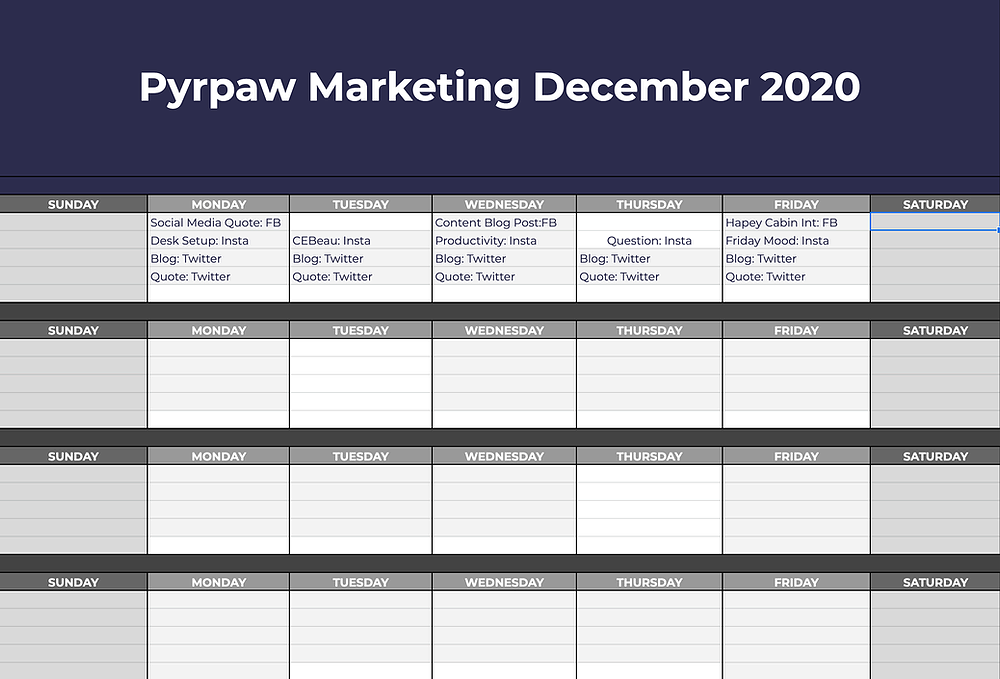I’ve discussed the effects of an inconsistent posting schedule and introduced the idea of the Social Media Content Calendar. A content calendar is a great tool to help you in the development of a social media marketing strategy and today’s post, we’ll go through the process of setting one up: Mine!
“According to Content Marketing Institute, 72% of B2B marketers attribute the success (which has increased annually) of their content to the development of a formal content strategy.” (Hubspot)
NOTE: By using a Buyer Persona to inform the type of content my ideal clients want to see , it’s much easier to develop a content calendar for your social media efforts.
Why Do You Need a Social Media Content Calendar?
If you’re feeling overwhelmed with what you should post, when you should post, and where – a social media content calendar is nothing short of a miracle worker in becoming more confident in your online marketing efforts and organizing social media content.
Here are some of the top reasons to consider one:
- Post to Social Media Consistently
Taking the time to create a content calendar allows you to develop a schedule for what and when to post. If you don’t have to scrape together content at the last minute, your posting schedule becomes more consistent and your audience will become accustomed to hearing from you which builds your community and increases engagement.
- Save time in the long run by organizing your posts
If you develop a content calendar for your social media channels based on your business goals and buyer personas – You’re able to plan your content based on what will work best on each social channel. It takes the guesswork out of what content you’ll be publishing.
- Set and Track Your Social Media Goals
Creating your calendar based on your business goals means that you’re able to set which KPIs (Key Performance Indicators) will signal success with your efforts. You’ll be able to set goals on each social media channel and track their progress whereas before you’d have focused more on vanity metrics and executed a haphazard approach.
- Reduce the number of mistakes in your posts
One of the great side-effects of a content calendar is the ability to test links and proofread your content before posting to ensure your posts are clear, concise, and legible for your audience. Nothing sucks more than rushing to get a post out only to realize your audience probably thinks you can’t spell and you have to scramble to correct your errors. “Proper Preparation Prevents Piss Poor Performance”, as they say.
How To Create a Social Media Content Calendar
I’ve talked before about using content buckets for social media planning. These are simply groups of broad topics to organize my content ideas into. Here are mine, but yours will vary based on your particular needs:
- Blog posts
- Quotes
- Marketing Tips
- Article Shares
- Small Business Humor/Memes
- Behind The Scenes
- Questions/Polls
- Video

Content buckets color-coded like a boss.
These are the categories I’ll be adding content to for my social media posts. I’ll then pull from these social media content buckets to schedule all my posts for the month.
Planning Your Content
To plan my content, I’ve set a goal for the number of posts per week for each social media channel as follows:
- Facebook posts: 3 x a week
- Twitter: 10x a week
- Instagram posts: 5x a week
With my content buckets and posting volume in hand, I can start planning out my content calendar by making use of the following tabs in my Google Sheets:
Monthly Planning Calendar

A broad overview of all my posts for each social media channel
Facebook Updates

My dates, times, and content are specific to my Facebook content calendar.
Instagram Updates

My dates, times, and content are specific to my Instagram content calendar.
X/Twitter Updates

My dates, times, and content specific to Twitter
Content Buckets

Hashtags

Groups of hashtags curated for certain topics I can simply copy/paste into a post.
I use these tabs to plan out my posts according to each specific channel and ideal times for posting. We’ll dig deeper into the best times to post in another blog post soon.
Scheduling & Posting
Now that I have a game plan for my posting schedule, it’s time to do the actual scheduling – but how do we do that without shelling out hundreds of bucks a year on a fancy piece of software? Luckily, I have a few options that can save me time and money until I need something more robust. I’ll dive into that process in my next post.
Bonus: FREE SOCIAL MEDIA CONTENT CALENDAR TEMPLATE
I’ve created a simple but effective template you can use to create your content calendar for your social media posts. There’s also a quick calculator on the Content Bucket page that tracks how many content ideas you have and how many you need – all you need to do is add a few bits of info and you’re all set!
GET THE FREE TEMPLATEQuestions? Let me know in the comments below – I’d love to hear them!
